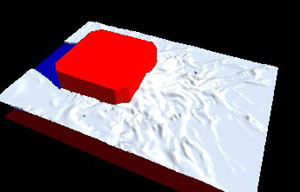
CARD used numerical simulation to quickly and cost-effectively mimic experiments and in situ processes in order to advance understanding of the fundamentals of ice behaviour on small and large scales. This improved understanding in turn lead to improved structural design and more efficient operational procedures. The CARD Numerical Modelling Group specialized in the use of Discrete Element Modelling (DEM) and meshless methods to study ice over a wide range of scales ranging from the small (e.g. examination of high pressure zones), to medium (e.g. interaction of level ice and ridges with structures/seabed), to large (e.g. influence of drifting ice floes on moored vessels). The Group used commercially-supported, open-source software and leveraged the high performance computing resources available from Compute Canada.